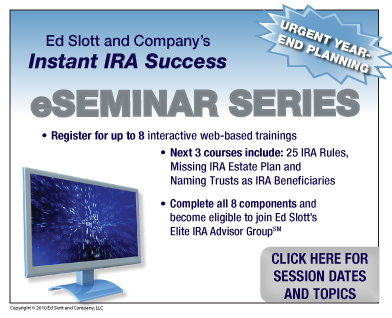
In This Update:
- What Happens to Gains or Losses on Recharacterizations
- Ruling to Remember: An Inherited IRA Mess
- Q of Month: What RMD Table to Use
Resources
- Ed as a Speaker
- Ed Slott's IRA Advisor Newsletter
- Shopping Cart
- Discussion Forum
- IRA Resources
- IRA and Tax Tables
Assistance
?? Question of The Month: What RMD Table To Use
Q: Previously, 100% of my IRA funds had my wife as beneficiary, and I used the RMD tables. I recently named my two children as beneficiaries for 30% of my IRA funds. When it comes to calculating the required RMD, do I still use the survivor tables for my wife's 70% fraction and the uniform tables for my children's portion?
A: Good question. At age 70 1/2 just about everyone will use the Uniform Lifetime Table to calculate required minimum distributions. The fact that you added your children as partial beneficiaries will not change that. The only exception is if a spouse was the sole beneficiary and he or she is greater than 10 years younger than the IRA owner. If that was the case, the joint life expectancy table could be used. However, you cannot use the Joint Life Table when the spouse is not the sole beneficiary; you must use the Uniform Lifetime Table.
CRITICAL STEPS YOU MUST ADDRESS NOW...
LAST CHANCE TO ATTEND IN 2010!
DON'T FORGET ABOUT GROUP DISCOUNTS! CALL 215-557-7022 FOR PRICING.
MAJOR IRA ROLLOVER MISTAKE YOU MUST KNOW
|
The October issue of Ed Slott's IRA Advisor Newsletter details a MAJOR IRA Rollover Mistake that cost a client taxes on over $500,000 due to a violation of the "once-per-year" IRA rollover rule. Also in this issue, a calendar of deadline dates lets you know the last days to establish a SIMPLE plan for 2010, recharacterize 2009 Roth conversions, withdraw the prior year excess IRA contributions, and more. |

|
Inside Ed Slott's IRA Advisor Newsletter$525,000 IRA Rollover Mistake! No Relief on This IRA Rollover Error
Guest IRA Expert
Roth IRA Tactics That Are Bound to Backfire If you are not already an Ed Slott's IRA Advisor Newsletter subscriber, you can preview past issues before subscribing. |
|
|
||
|
|||






 October Key Focus
October Key Focus
 Ruling to Remember
Ruling to Remember